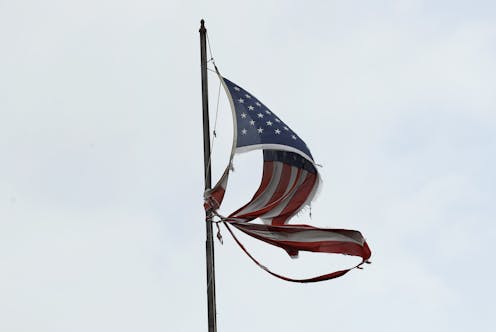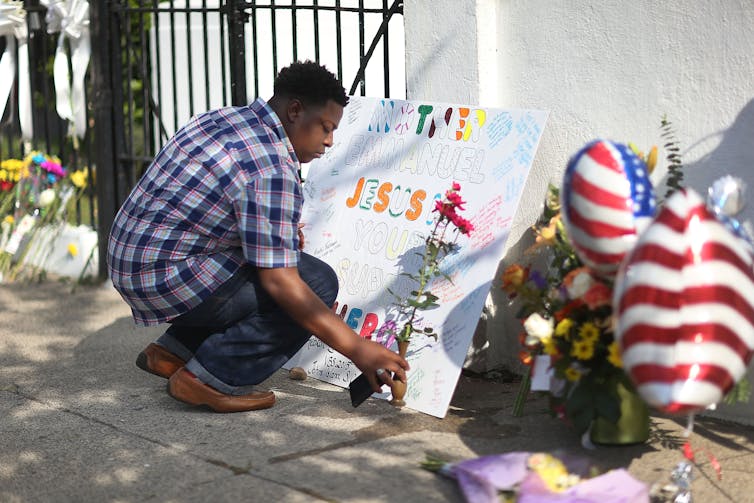Civil war in the US is unlikely because grievance doesn't necessarily translate directly into violence
- Written by Ore Koren, Assistant Professor of Political Science, Indiana University
 Will the U.S. be torn apart by civil war?Paul Sancya/AP photos
Will the U.S. be torn apart by civil war?Paul Sancya/AP photosThe potential for violent extremism in America to erupt into full-fledged conflict across the country is a common topic of discussion nowadays.
A recent FBI report highlights an increasing risk of violence against government institutions, private organizations and individuals. The possible perpetrators: primarily “lone wolves,” but potentially also militias and other organized groups such as animal activists, anti-abortionists and white supremacists.
Claims that America is at the greatest risk of civil war since, well, the Civil War, recently received additional support from some experts in the field of political science.
But civil wars are rare events.
Before the 2020 election, I analyzed the risk of a so-called “Second American Civil War” that some speculated might ignite on or around Election Day. I concluded the risk was very low, while also emphasizing the uncertainty of the times.
Despite the ugly Capitol riot of Jan. 6, 2021, and anti-racism protests of the past few years, some of which included rioting, violent confrontation, and property destruction, my analysis has held, and I remain unconvinced that America is likely to descend into civil war in the near future.
Before proceeding, I want to stress that, as a scholar who studies civil conflict, I discuss the manifestations of violence here not on the basis of their underlying political ideologies but in relation to empirical definitions of different types of political violence.
Grievance doesn’t translate into violence
Researchers usually define civil wars based on a certain threshold of combatant deaths, often 1,000 or more.
In 2020, for example, only eight conflicts crossed that threshold worldwide. They happened in countries – including Syria, Iraq, Afghanistan, Nigeria, Ethiopia, and Yemen – experiencing rampant poverty and underdevelopment, nondemocratic or dysfunctional political institutions, and a long history of conflict along ethnic and religious lines.
 What real civil war looks like: Members of the Syrian Civil Defense sort bodies of victims following Syrian government forces airstrikes on March 5, 2020, in the Idlib province.Aaref Watad/AFP via Getty Images
What real civil war looks like: Members of the Syrian Civil Defense sort bodies of victims following Syrian government forces airstrikes on March 5, 2020, in the Idlib province.Aaref Watad/AFP via Getty ImagesWhen trying to assess the likelihood of civil war, researchers first look at whether people are willing to engage in violence. Willingness is often attributed to anger and grievances over inequality or political marginalization.
Individuals or groups may have grievances with specific state or national policies, or with other groups. As their anger grows, these people may not only use aggressive and demeaning language, but also become more accepting of the idea of using violence.
Anger and grievances are probably the most frequently highlighted issues in the mainstream media, and especially in social media outlets. Studies of social media outlets have found that their algorithms are designed to amplify anger to appeal to wider groups.
Aggrieved people, however, exist almost everywhere, even in the world’s happiest countries. Feeling aggrieved and even using harsh and violent rhetoric does not mean a person is willing to take up arms against the government or one’s fellow citizens.
Risks to joining a rebellion
But even if they are fully willing, in almost every case, civil war will not happen unless these very angry people have the opportunity to organize and use violence on a large scale.
Joining a rebellion is extremely risky. You can die or be severely wounded. Your chances of winning are low. If you don’t win, even if you survive unscathed, you still risk prosecution and social alienation. You may lose your job, your savings and even your home and put your family at risk.
It doesn’t matter how angry you are, these considerations are usually prohibitive.
All these calculations are part of what economists call “opportunity costs.” Opportunity costs basically measure how much you would have to potentially give up if you were to engage in a given activity, such as rebellion.
In most countries afflicted by civil war, poverty, economic downturn and even food insecurity mean that these costs are relatively low. An unemployed farm laborer in rural Mozambique has, from an economic perspective at least, less to lose from joining an extremist insurgency than, say, Robert Scott Palmer, owner of a cleaning and restoration company from Largo, Florida.
Apparently willing to risk his livelihood by using violence against police during the Jan. 6 riot, Palmer was thwarted by other factors that are highly relevant in determining the potential for a full-fledged rebellion – the government’s capacity to punish and deter violence, and the opportunity, or lack of opportunity, for dissidents to organize and mobilize effectively enough to start a war.
For example, people who want to organize and rebel against the government will find it easier to do in remote areas where the government cannot know or reach them. Tora Bora – the cave complex in the mountain of eastern Afghanistan – is an example of such a place. Insurgents can hide and train there, practically unknown to, and untouchable by, Afghanistan’s military, which generally lacks the capabilities and capacity of its American counterpart.
The high levels of American policing and intelligence capacity mean that insurgency opportunities are rare in the U.S. Individuals who organize, arm themselves and decide to act against the government risk being detected and thwarted before they can become real threats.
Moreover, because of the low urban density of the U.S., even if such rebels are successful in organizing – in rural Alaska, for example – they will be unable to reach, let alone conquer, big cities or threaten American sovereignty in significant ways.
‘Intensified domestic terrorism’
 There could be more violent attacks in the U.S. Here, a man pays respects in front of Emanuel African Methodist Episcopal Church after a mass shooting at the church that killed nine African Americans on June 19, 2015.Joe Raedle/Getty Images
There could be more violent attacks in the U.S. Here, a man pays respects in front of Emanuel African Methodist Episcopal Church after a mass shooting at the church that killed nine African Americans on June 19, 2015.Joe Raedle/Getty ImagesThese low opportunities suggest that civil war in America is still unlikely. But this does not preclude the occurrence of other forms of less intense violence. Concerns about increased violent extremism in the United States recently led the U.S. Justice Department to establish a new domestic terrorism group.
It is possible we might see a rise in the number of organized domestic terror attacks – along the lines of the British experience during its conflict with the Provisional Irish Republican Army or the U.S. experience with the Weather Underground during the 1960s and 1970s.
[More than 140,000 readers get one of The Conversation’s informative newsletters.Join the list today.]
More likely is an increase in so-called “lone wolf” attacks, such as the Emanuel African Methodist Episcopal Church Shooting, the 2016 Orlando nightclub shootings or the 2010 Austin suicide attack on a four-story building that housed an IRS field office. These may become more prevalent because of the spread of violent messages on social media and the “gamification” of violence, for instance via competitive point-scoring detected by the FBI among violent individuals.
Because they often involve one individual, “lone wolf” attacks are harder to identify and prevent, which increases the opportunity for individuals to engage in violence. But the costs of doing so remain high.
Start at the top
What can be done to reduce the risk of violence?
A well-functioning and effective government security organization combined with a vibrant economy lowers conflict opportunity. But taking aim at factors that make people willing to engage in violence might be another effective strategy.
This could start from the top.
The risk of radicalization is the highest when government leaders themselves attack government institutions to achieve short-term political goals.
Politicians and activists can disagree, but if they also continue to reaffirm their trust in the American political and legal systems, which are still among the world’s best in terms of ensuring equal political participation, personal freedoms and economic prosperity, that could go a long way toward discouraging willingness to engage in anti-government or other types of political violence.
Ore Koren does not work for, consult, own shares in or receive funding from any company or organization that would benefit from this article, and has disclosed no relevant affiliations beyond their academic appointment.
Authors: Ore Koren, Assistant Professor of Political Science, Indiana University
